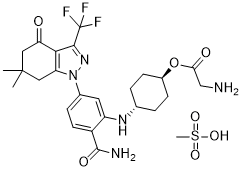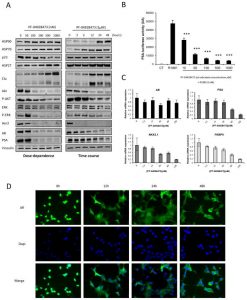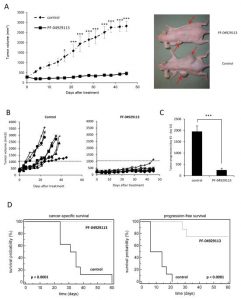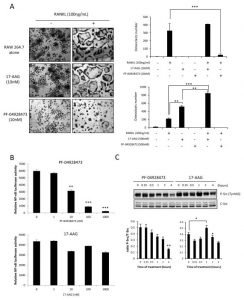This product is for research use only, not for human use. We do not sell to patients.

| Size | Price | Stock |
|---|---|---|
| 5mg | $68 | 3-6 Days |
| 10mg | $98 | 3-6 Days |
| 25mg | $150 | 3-6 Days |
| 50mg | $250 | 3-6 Days |
| 100mg | $450 | 3-6 Days |
| 250mg | $750 | 3-6 Days |
| 500mg | $1250 | 3-6 Days |
Cat #: V3758 CAS #: 1173111-67-5 Purity ≥ 98%
Description: PF-04929113 mesylate (also known as SNX-5422 mesylate) is a potent and selective inhibitor of heat shock protein 90 (HSP90) with Kd of 41 nM, it induces Her-2 degradation with IC50 of 37 nM. PF-04929113 is a synthetic prodrug of SNX-2112 with potential antineoplastic activity. PF-04929113 is rapidly converted to SNX-2112, which accumulates in tumors relative to normal tissues. SNX-2112 inhibits Hsp90, which may result in the proteasomal degradation of oncogenic client proteins, including HER2/ERBB2, and the inhibition of tumor cell proliferation.
Publications Citing InvivoChem Products
Product Promise

- Physicochemical and Storage Information
- Protocol
- Related Biological Data
- Stock Solution Preparation
- Quality Control Documentation
| Molecular Weight (MW) | 617.64 |
|---|---|
| Molecular Formula | C26H34F3N5O7S |
| CAS No. | 1173111-67-5 |
| Storage | -20℃ for 3 years in powder form |
| -80℃ for 2 years in solvent | |
| Solubility In Vitro | DMSO: 5 mg/mL (9.6 mM) |
| Water:<1 mg/mL | |
| Ethanol: 3 mg/mL (5.2 mM) | |
| Solubility In Vivo | 0.5% CMC+0.25% Tween 80: 25mg/mL |
| Synonyms | SNX-5422 mesylate; SNX5422; SNX 5422; PF4929113; PF-4929113 mesylate; PF 4929113; PF04929113; PF 04929113; PF-04929113 mesylate |
| Protocol | In Vitro | In vitro activity: PF-04929113 is a small-molecule Hsp90 inhibitor based on the 6,7-dihydro-indazol-4-one scaffold. PF-04929113 developed by Serenex, converts to SNX-2122, which is the active Hsp90 inhibitor form. PF-04929113 exhibits potent effects on Her-2 stability and causes expected up-regulation of Hsp70. PF-04929113 shows potent antiproliferative activity against a broad range of cancer cell types, e.g. MCF-7 (IC50=16 nM), SW620 (IC50=19 nM), K562 (IC50=23 nM), SK-MEL-5 (IC50=25 nM), and A375 (IC50=51 nM). Kinase Assay: Hsp90 from porcine spleen extract is isolated by affinity capture on a purine-affinity media. The Hsp90 loaded media is then challenged with PF-04929113 at a given concentration, ranging from 0.8 to 500 μM, and the amount of Hsp90 liberated at each concentration is determined by Bradford protein assay. The resulting IC50 values are corrected for the ATP ligand concentration and presented as apparent Kd values. Cell Assay: All assays are done in 96-well plates. All cell lines are purchased from ATCC. Proliferation rates are measured by seeding cells (MCF-7, SW620, K562, SK-MEL-5 and A375 cancer cell lines) into 96-well plates, followed by compound addition 24 h later. After addition of PF-04929113, cells are allowed to grow for either an additional 72 or 144 h depending on rate of growth. At harvest, media is removed and DNA content for individual wells is determined using CyQuant DNA dye. Levels of Hsp90 client proteins and phosphor-regulated proteins in A375 are measured by high content analysis (HCA) using an ArrayScan 4.5 instrument after 24 hours of treatment with PF-04929113, followed by methanol fixation. After fixation in 4% PBS-buffered formalin and permeablization with 0.1% TX-100, cells are probed with anti-Her2, antiphospho-S6 (pS6), antipERK, and anti-Hsp70 primary antibodies, followed by TRITC or FITC conjugated secondary antibodies. Nuclei are also stained with Hoechst DNA binding dye. For each well, 250-500 individual nuclei are identified along with the average staining intensity for the client and phospho-proteins for each cell. Average client staining intensities are then calculated for each well. |
|---|---|---|
| In Vivo | PF-04929113 inhibits human MM cell growth in vivo, and immuno-histochemical analysis shows PF-04929113 significantly inhibits p-ERK and p-Akt in treated mice. Meanwhile, PF-04929113 treatment significantly decreases the percentage of CD31+ cells and MVD, consistent with an inhibitory effect on angiogenesis in vivo. A 50 mg/kg administration of PF-04929113 delivered 3 times per week significantly delays castrate-resistant LNCaP tumor growth and prolongs cancer specific survival. Immuno-histochemical analysis indicates increased SP70 expression, and decreases Ki67, Akt, and AR expression, after treatment with PF-04929113. Inhibition of tumor progression by PF-04929113 may result from a combination of decreased proliferative (reduced Ki67 and Akt expression) or increased apoptosis (increased ApopTag staining) rates. | |
| Animal model | Fox Chase SCID mice bearing MM.1S cells |
| Solvent volume to be added | Mass (the weight of a compound) | |||
|---|---|---|---|---|
| Mother liquor concentration | 1mg | 5mg | 10mg | 20mg |
| 1mM | 1.6191 mL | 8.0953 mL | 16.1907 mL | 32.3813 mL |
| 5mM | 0.3238 mL | 1.6191 mL | 3.2381 mL | 6.4763 mL |
| 10mM | 0.1619 mL | 0.8095 mL | 1.6191 mL | 3.2381 mL |
| 20mM | 0.0810 mL | 0.4048 mL | 0.8095 mL | 1.6191 mL |
This equation is commonly abbreviated as: C1 V1 = C2 V2
- (1) Please be sure that the solution is clear before the addition of next solvent. Dissolution methods like vortex, ultrasound or warming and heat may be used to aid dissolving.
- (2) Be sure to add the solvent(s) in order.







































